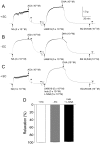Selective and potent inhibitory effect of docosahexaenoic acid (DHA) on U46619-induced contraction in rat aorta
- PMID: 24304639
- PMCID: PMC5137318
- DOI: 10.1540/jsmr.49.63
Selective and potent inhibitory effect of docosahexaenoic acid (DHA) on U46619-induced contraction in rat aorta
Abstract
Inhibitory effects of docosahexaenoic acid (DHA) on blood vessel contractions induced by various constrictor stimulants were investigated in the rat thoracic aorta. The inhibitory effects of DHA were also compared with those of eicosapentaenoic acid (EPA) and linoleic acid (LA). DHA exhibited a strong inhibitory effect on the sustained contractions induced by U46619, a TXA(2) mimetic. This inhibitory effect of DHA was not affected by removal of the endothelium or by treatment with either indomethacin or N(ω)-nitro-l-arginine. DHA also significantly diminished PGF(2α)-induced contraction but did not show any appreciable inhibitory effects on the contractions to both phenylephrine (PE) and high-KCl. Similarly, EPA exhibited significant inhibitory effects against the contractions induced by both U46619 and PGF(2α) without substantially affecting either PE- or high-KCl-induced contractions. However, both DHA and EPA generated more potent inhibitions against contractions induced by U46619 than those by PGF(2α). In contrast, LA did not show significant inhibitory effects against any contractions, including those induced by U46619. The present findings suggest that DHA and EPA elicit more selective inhibition against blood vessel contractions that are mediated through stimulation of prostanoid receptors than those through α-adrenoceptor stimulation or membrane depolarization. Although DHA and EPA have similar inhibitory potencies against prostanoid receptor-mediated contractions, they had a more potent inhibition against TXA(2) receptor (TP receptor)-mediated contractions than against PGF(2α) receptor (FP receptor)-mediated responses. Selective inhibition by either DHA or EPA of prostanoid receptor-mediated blood vessel contractions may partly underlie the mechanisms by which these ω-3 polyunsaturated fatty acids exert their circulatory-protective effects.
Figures





Similar articles
-
Docosahexaenoic acid and eicosapentaenoic acid strongly inhibit prostanoid TP receptor-dependent contractions of guinea pig gastric fundus smooth muscle.Pharmacol Res Perspect. 2022 Jun;10(3):e00952. doi: 10.1002/prp2.952. Pharmacol Res Perspect. 2022. PMID: 35466586 Free PMC article.
-
Pharmacological characteristics of the inhibitory effects of docosahexaenoic acid on vascular contractions studied in rat mesenteric artery.Pharmacology. 2014;93(5-6):229-43. doi: 10.1159/000360543. Epub 2014 Jul 8. Pharmacology. 2014. PMID: 25012911
-
Docosahexaenoic acid inhibits U46619- and prostaglandin F2α-induced pig coronary and basilar artery contractions by inhibiting prostanoid TP receptors.Eur J Pharmacol. 2021 Oct 5;908:174371. doi: 10.1016/j.ejphar.2021.174371. Epub 2021 Jul 28. Eur J Pharmacol. 2021. PMID: 34329614
-
Comparison of the inhibitory effects of docosahexaenoic acid (DHA) on U46619- and phenylephrine-induced contractions in guinea-pig aorta.Biol Pharm Bull. 2005 Jul;28(7):1298-300. doi: 10.1248/bpb.28.1298. Biol Pharm Bull. 2005. PMID: 15997118
-
DHA, RvD1, RvD5, and MaR1 reduce human coronary arteries contractions induced by PGE2.Prostaglandins Other Lipid Mediat. 2023 Apr;165:106700. doi: 10.1016/j.prostaglandins.2022.106700. Epub 2022 Dec 15. Prostaglandins Other Lipid Mediat. 2023. PMID: 36528331 Review.
Cited by
-
Eicosapentaenoic acid (EPA)-induced inhibitory effects on porcine coronary and cerebral arteries involve inhibition of prostanoid TP receptors.Sci Rep. 2022 Jul 27;12(1):12829. doi: 10.1038/s41598-022-16917-6. Sci Rep. 2022. PMID: 35896794 Free PMC article.
-
Omega-3 Fatty Acids in Arterial Hypertension: Is There Any Good News?Int J Mol Sci. 2023 May 30;24(11):9520. doi: 10.3390/ijms24119520. Int J Mol Sci. 2023. PMID: 37298468 Free PMC article. Review.
-
Docosahexaenoic acid and eicosapentaenoic acid strongly inhibit prostanoid TP receptor-dependent contractions of guinea pig gastric fundus smooth muscle.Pharmacol Res Perspect. 2022 Jun;10(3):e00952. doi: 10.1002/prp2.952. Pharmacol Res Perspect. 2022. PMID: 35466586 Free PMC article.
-
Docosahexaenoic Acid Supplemented Diet Influences the Orchidectomy-Induced Vascular Dysfunction in Rat Mesenteric Arteries.PLoS One. 2017 Jan 9;12(1):e0168841. doi: 10.1371/journal.pone.0168841. eCollection 2017. PLoS One. 2017. PMID: 28068359 Free PMC article.
-
Inhibitory mechanisms of docosahexaenoic acid on carbachol-, angiotensin II-, and bradykinin-induced contractions in guinea pig gastric fundus smooth muscle.Sci Rep. 2024 May 22;14(1):11720. doi: 10.1038/s41598-024-62578-y. Sci Rep. 2024. PMID: 38778154 Free PMC article.
References
-
- Iso H, Kobayashi M, Ishihara J, Sasaki S, Okada K, Kita Y, Kokubo Y, Tsugane S; JPHC Study Group. Intake of fish and n3 fatty acids and risk of coronary heart disease among Japanese: the Japan Public Health Center-Based (JPHC) Study Cohort I. Circulation. 2006; 113(2): 195–202. doi: 10.1161/CIRCULATIONAHA.105.581355 - DOI - PubMed
Publication types
MeSH terms
Substances
LinkOut - more resources
Full Text Sources
Other Literature Sources
Research Materials

